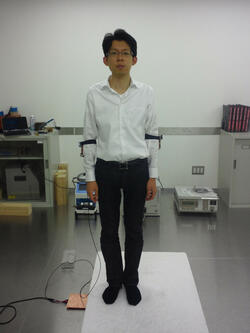
Haga, Nozomi
| Affiliation | Department of Electrical and Electronic Information Engineering |
|---|---|
| Title | Associate Professor |
| Fields of Research | Communication Engineering |
| Degree | Ph.D. (Chiba University) |
| Academic Societies | IEICE / IEEE |
| haga.nozomi.ok@ Please append "tut.jp" to the end of the address above. |
|
| Researcher information URL(researchmap) | Researcher information |
Research
We are conducting research on wireless technology using electromagnetic waves. In particular, we are exploring originality in numerical simulation techniques for electromagnetic waves and their application to wireless power transfer and body-centric wireless communications.Theme1:Analysis and Design Techniques for Wireless Power Transfer Systems
Overview
Wireless power transfer systems are expected to be applied to the charging of mobile devices and electric vehicles. To design systems with high efficiency, it is common to represent the couplers (coils or electrodes) between transmitting and receiving devices as circuit elements such as inductors or capacitors. However, such simplistic models do not tell us about the effects of the coupler radiating radio waves like an antenna, or the effects of the proximity of dielectric or magnetic materials, or water or the human body to the coupler. In this theme, a novel numerical electromagnetic field analysis method has been developed to consider these effects from the desk top design stage of the system, and this method is used for highly accurate circuit modeling.
Selected publications and works
[1] N. Haga, J. Chakarothai, and K. Konno, “Circuit modeling of a wireless power transfer system containing ferrite shields using an extended impedance expansion method,” IEEE Trans. Microw. Theory Techn., vol. 70, no. 5, pp. 2872–2881, May 2022.
[2] N. Haga, J. Chakarothai, and K. Konno, “Circuit modeling of wireless power transfer system in the vicinity of perfectly conducting scatterer,” IEICE Trans. Commun., vol. E103-B, no. 12, pp. 1411–1420, Dec. 2020.
[3] N. Haga and Masaharu Takahashi, “Circuit modeling of a wireless power transfer system by eigenmode analysis based on the impedance expansion method,” IEEE Trans. Antennas Propag., vol. 67, no. 2, pp. 1233–1245, Feb. 2019.
Keywords
Theme2:Analysis and Measurement Techniques for Body-Centric Wireless Communications
Overview
Systems that establish communication when the wearer touches a ticket gate or floor mat while wearing a wearable communication device have been developed by domestic manufacturers. However, such systems are vulnerable to electromagnetic noise emitted by other electronic devices. In this theme, we are researching analysis and measurement techniques to design systems that are resistant to electromagnetic noise.
Selected publications and works
[1] N. Haga, Y. Kasahara, and K. Motojima, “Statistical modeling of intrabody communication channels in various grounding conditions,” IEICE Commun. Express, vol. 6, no. 6, pp. 319–324, June 2017.
[2] N. Haga, Y. Kasahara, and K. Motojima, “Dynamic measurements of intrabody communication channels and their dependences on grounding conditions,” IEICE Trans. Commun., vol. E99-B, no. 6, pp. 1380–1385, June 2016.
[3] N. Haga, K. Motojima, M. Shinagawa, and Y. Kado, “Equivalent-circuit expression of environmental noise electric fields in intrabody communication channels,” IEEE Trans. Electromag. Compat., vol. 58, no. 1, pp. 294–306, Feb. 2016.
Keywords
Title of class
Signal Processing



